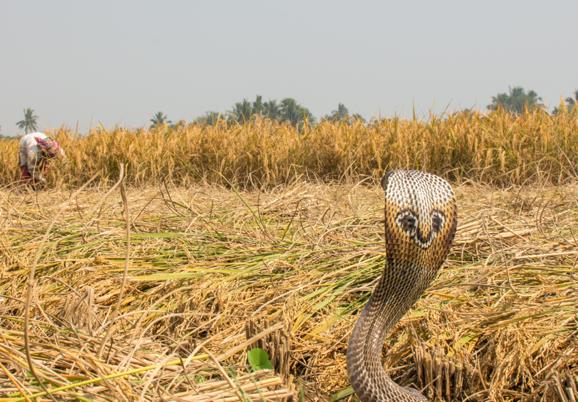
Snakebite Is A Public Health Problem
Colombo, March 3: Bites of venomous snakes cause significant morbidity and mortality in the rural areas of tropical countries. Despite this, until recently, snakebites did not receive the attention they deserved as a public health problem.
The main reason for this was the paucity of robust epidemiological data on the disease burden associated with snakebite.
ADVERTISEMENTWorld-wide, an estimated 5.4 million people are bitten by snakes each year and 1.8 to 2.7 million are“envenomed” or poisoned. Around 81,410 to 137, 880 persons die each year because of snake bites. Around three times as many amputations and other permanent disabilities are caused by snakebites annually. The situation is grim indeed.
Snakebites are an enormous problem in India which records one million snakebites and 58,000 deaths due to these annually. This means that half the deaths due to snakebites in the world occur in India. Cases of disabilities created by snakebites in India are said to be four times the number of deaths.
Hospital statistics in the countries of the Global South underestimate the number of snakebites because a significant proportion of victims in these tropical countries seek traditional treatments outside hospitals. Because of this there is a gross under-estimation of deaths because of snakebites also.
Aanya Wipulasena said in her article in Daily Express that in 2019, as per the Sri Lankan Health Ministry, there were 34,239 cases of snakebites reported to State hospitals. But according to a doctor attached to the Expert Committee on Snakebites (ECS) of the Sri Lanka Medical Association, the annual snakebite incidence was as high as 61,000. The two institutions had different statistics on deaths due to snakebite also. According to the Health Ministry, 50 had died of snakebite in 2019, but the doctor from the ECS said it was 200.
Karnataka's Lead
It is because of the lack of data that the government of the State of Karnataka in South India, made snakebite a“notifiable disease”. On February 12, the Karnataka government issued directives to all hospitals and medical colleges in the State to mandatorily record snakebite cases and deaths in the Integrated Health Information Platform (IHIP), which is a common Central government portal for national disease surveillance. The directive was given under the Karnataka Epidemic Diseases Act, 2020. Snakebite is of epidemic proportion.
This step will help the government not only get the numbers right but also region-wise incidence of snakebites and deaths, to enable an effective response.
Productive Age Group Affected
“It's a big first step,” said cardiologist Dr Jaideep C. Menon, who is currently leading an Indian Council of Medical Research (ICMR) study on snakebite incidence and mortality in India. According to Dr. Menon, 70% of snakebite victims are in the productive age group of 20-65 and is therefore a major economic problem too.
The other noteworthy feature is that 80% of the patients still depend on alternate sources of treatment before reaching a modern medical facility. Part of the reason for this scenario is that most snakebite cases occur in rural areas and many primary health centres lack the trained human resources and facilities to admit and treat patients with snakebite in India.
b
Sri Lankan researcher Dileepa Senajith Ediriweera and colleagues had mapped the risk of snakebite in Sri Lanka through a national survey with geospatial analysis conducted in all the nine provinces of the country. Data relating to 165,665 individuals (0.8% of the population of Sri Lanka) living in 44,136 households in 1,118 clusters were collected.
695 snakebites, 323 envenomings (poisonings) and 5 deaths (four of them male) were reported in the sample population in the 12 months preceding the survey. The incidence of snakebites, envenoming and deaths in the complete sample population was 398, 151, and 2.3 per 100,000 population respectively.
Extrapolating this to the population of the whole of Sri Lanka, the estimated national numbers of snakebites, envenoming and deaths were 80,514, 30,543 and 464 respectively.
These figures were much more than claimed by official statistics, the researchers point out. There was variation in numbers of bites and envenomings in different parts of the country and, using the data from the survey, the researchers were able to develop snakebite risk maps to identify snakebite hotspots and cold spots in the country.
To encourage others studying the problem, the researchers used free and open source software and replicable methods, which could be adopted to other regions where snakebite is a public health problem.
Seyed Shahmy and his colleagues in their research paper (BMC Medical Education Volume 23, Article number: 390 (2023) say that
differences in rainfall have led to much diversity in the flora and fauna, and in land use in Sri Lanka, leading to differences in snakebite patterns.
A country-wide community based cross sectional survey between August 2012 and June 2013 to sample approximately 1% of the population of Sri Lanka. The researchers found that there were over 80,000 bites, 30000 envenomings, and 400 deaths per year in Sri Lanka. Hospital data underestimated deaths due to snakebite by as much as 60%.
Regional Variations
The highest rates of bites and envenoming were seen in the rural and agricultural North Central and North Eastern regions of the country.
In keeping with other parts of the world, the highest disease burden due to venomous snakebite affects areas with the population groups that are most under-served in terms of healthcare and infrastructure. This re-emphasizes the need for an equitable distribution of resources to address the problem of snakebites.
As in India, in Sri Lanka too, rural males of working age were at high risk of snakebites due to high exposure levels associated with their lifestyle and occupation, mainly farming.
The research also showed that the incidence of snakebite and envenoming gradually decreased with increasing population density. This may be due to the more densely populated areas being less suitable as habitats for sakes.
Coastal Areas Safer
Snakebite incidence increased with increasing elevation up to 160 meters and thereafter dropped with increasing elevation, likely reflecting the fact that coastal areas are not generally suitable for snake habitats.
Snakebite incidence is dramatically lower in non-agricultural communities (less than 9% involved in agriculture. The incidence of snakebite is higher in both the intermediate and wet zones than in the dry climatic zone.
However, the overall incidence of envenoming is higher in the dry zone. This is likely to reflect variation in species and again shows the importance of capturing data on the incidence of both snakebite and envenoming.
Russell's viper is the most widely distributed snake in Sri Lanka, and can be found up to an elevation of 1800 meters. Saw-scaled vipers are largely confined to the arid dry zones of the country including Northern and Eastern Provinces extending up to eastern parts of the Southern Province. Cobras are also widely distributed in the country and are found up to 1500 meters. Common Kraits are mainly found in the dry zone. Hump-nosed vipers are found all over the country, but mostly in the wet and intermediate zones.
Need for Treatment in Primary Hospitals
Researchers have noticed that even in the case of medically minor snakebites, the majority of patients who come to the primary hospitals are subsequently transferred to hospitals at the higher level for further management. Perhaps doctors in primary care hospitals feel that their reputation will be at stake if a death occurred under their care. This adds to the cost of the treatment.
But given the high quality of overall management in the primary hospitals in Sri Lanka, such transfers are unnecessary. As over 80% of snakebites in Sri Lanka are treated in primary hospitals, steps could be taken to discourage transfer of patients to higher hospitals, the researchers say.
Production of Anti-Venom
The urgent necessity of safe and specific anti-venom for Sri Lankan snakes has been recognized by the Ministry of Health. Setting up a production facility in Sri Lanka itself will cost US$ 4 million.
Therefore, venom from Sri Lankan snakes are collected and sent abroad for the production of a suitable anti-venom, according to the National Research Council.
END

Legal Disclaimer:
MENAFN provides the information “as is” without warranty of any kind. We do not accept any responsibility or liability for the accuracy, content, images, videos, licenses, completeness, legality, or reliability of the information contained in this article. If you have any complaints or copyright issues related to this article, kindly contact the provider above.






















Comments
No comment